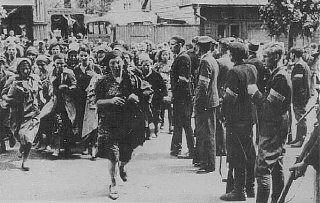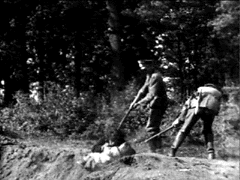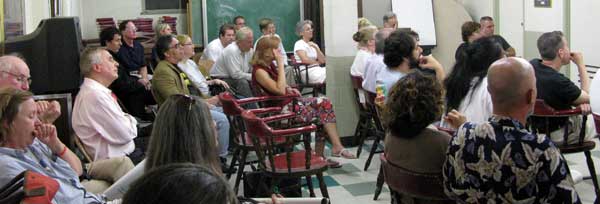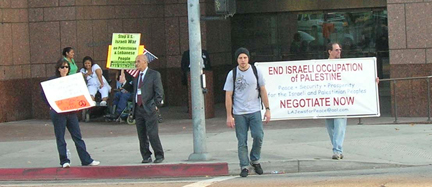Regular readers of this blog have noticed several posts relating to the small Baltic state of Lithuania and its horrendous record of official Holocaust denial and anti-Semitism. (Read
here and
here and
here). The government of Lithuania has been engaged in a campaign designed to silence or discredit eyewitnesses and scholars who have revealed Lithuanian collaboration in Holocaust atrocities.
This campaign is of the same type as much contemporary anti-Semitism. Rather than seeking to portray Jews as worthy of oppression, it targets Jews as oppressors. In this instance, Jews who reveal Lithuanian collaboration are slandered as collaborators in Soviet oppression of Lithuanians.
Now comes word from the blog Rootless Cosmopolitan that at least one recent chapter of official Lithuanian Holocaust denial may be coming to a close (
read here), largely as a result of the intervention of the Simon Wiesenthal Center (
read here). Of course, it remains to be seen whether the Lithuanians truly cease this attempt to rewrite history and persecute those who witnessed it.
Below, I've posted a brief article written by the cousins of Rachel Margolis, one of the Lithuanian Jewish survivors of the Holocaust who has spoken up about the role of Lithuanian collaborators. In addition to being a survivor and eyewitness to the Holocaust, she is a scholar who has uncovered other eyewitnesses. It is her role as scholar which brought her to the attention of the Lithuanian security service. Below that, I've posted an excerpt from an article published recently in Haaretz dealing with the same set of facts.
The book mentioned below,
Ponary Diary, 1941-1943: A Bystander's Account of a Mass Murder by Kazimierz Sakowicz is available from Amazon
here. Excerpts are available from Google Books here. More background, featuring photographs of Rachel Margolis, is available in
this article (pdf). This piece from BBC News (
read here) also provides some useful background to the case.
from the Cleveland Jewish News:
From hero to harassed: Lithuania’s campaign against Holocaust survivors
BY: BUDD MARGOLIS and MARJORIE MARGOLIS
Our cousin Rachel Margolis is not in her native Vilnius this summer, as she has been in summers past, to teach visitors from around the world about Lithuania’s role in the Holocaust.
Despite the fact that the Lithuanian prime minister honored her three years ago as a war hero, the Lithuanian government is now turning on her and the country’s other few surviving Jews.
As a member of the EU, Lithuania is obligated to research and reconcile its role in the Holocaust. However, it has failed to convict a single one of its citizens of the war crimes documented in the Sakowicz diary, an eyewitness account by a non-Jew of the mass killings of Jews and Poles at Ponary, Lithuania. (See related article on p. 39.)
Instead, Lithuanian prosecutors are culling the memoirs of survivors like our cousin Rachel to find evidence of deaths of Lithuanian citizens at the hands of pro-Soviet partisans. (Rachel wrote a memoir recounting her escape from the ghetto and her experiences as a partisan.)
This is the government’s shameless attempt to divert attention away from its failure to ever seriously punish a single mass murderer.
Against this European context, the local shenanigans against survivors have unfolded. In 2005, Holocaust survivor and resistance fighter Yitzhak Arad, who for 21 years was director of the Yad Vashem Holocaust Memorial Museum in Jerusalem, was persuaded to join a Lithuanian commission investigating Nazi and Soviet crimes. A short time later, a blatantly racist newspaper article accused him of “war crimes” based on passages in his book The Partisan. On the heels of that, an equally racist prosecutor followed suit.
The same pathetic sequence unfolded again on Jan. 29, 2008. a blatantly anti-Semitic and vicious article appeared in a daily newspaper in Vilnius misquoting and misusing a passage in our cousin Rachel’s memoir (published in Russian) as “evidence” against Fania Brantsovsky, now 86 and librarian of the Vilnius Yiddish Institute at Vilnius University.
In response to these outrageous and unwarranted claims, the Yiddish institute organized a certificate of honor for Brantsovsky, as did the American Embassy in Vilnius. Both were awarded to her on April 30.
Five days later, however, men in dark suits came to Rachel’s home looking for her as a “witness against Fania.”
Even more recently, on Aug. 9, erev Tisha b’Av, which marks the fall of the Holy Temple in Jerusalem, the Jewish Community Center in Vilnius was vandalized. Anti-Semitic grafitti was scrawled on the walls and windows of the building.
Lithuania’s hatred for its few remaining Jews grows worse and worse, seemingly daily.
Incredible! The country with the worst Holocaust record in Europe, while failing to punish any of the mass murderers of its Jewish population, has decided, in 2008, to continue its campaign of defamation, harassment and intimidation against the tiny handful of Holocaust survivors who are alive precisely because they joined the anti-Nazi partisans and fought valiantly against the German war machine in the forests outside Vilna
But you haven’t heard the greatest absurdity: The European community has bestowed on Vilnius the status of “Capital of European Culture” for 2009. Alas, a more apt description would be Capital of European Racism, Anti-Semitism and Holocaust Denial.
We do not want the Lithuanian government to benefit from the injustices it has committed. We do want the interrogation, defamation and harassment of people like Yitzhak Arad, Fania Brantsovsky, and Rachel Margolis to stop; we want these bona fide heroes to be welcome in Lithuania so that they can continue their Holocaust education of others.
Budd Margolis is a native Clevelander, and his cousin Marjorie Margolis joined him and other Cleveland teens on two teen tours led by his father Henry Margolis, director of the Cleveland Bureau of Jewish Education in the ’70s.
Lithuanian Nazi war criminals
Algimantas Dailide- Former operative of the Saugumas (Lithuanian Security Police), Vilna District. A Cleveland-based realtor, Dailide remains in Cleveland.
Aleksandra Lileikis (died mid-trial)
Kazys Gimzauskas (suffers from Alzheimer’s)
All three were denaturalized and ordered deported, but for various reasons were never punished.
Haaretz had this to say about Rachel Margolis' run in with the Lithuanian security service (read here):A few months ago, Lithuanian policemen and agents from the security service knocked on Rachel Margolis' door in Vilna. Fortunately she was not home, and was thus saved the humiliation of an interrogation. Margolis, almost 90, was a Jewish partisan during World War II, and is finding it difficult to recover from the trauma even now, when she is living in her daughter's home in Rehovot.
"My sin in the eyes of the nationalists and the anti-Semites in the Lithuanian government," she says, "was that I was a partisan and fought against the Nazis and their collaborators."
The Lithuanian policemen and agents wanted to interrogate her about her memoir, in which she told about her partisan colleagues who in January 1944 attacked the village of Koniuchy (or in Lithuanian, Kaniukai).
The Lithuanian partisans, who operated under the aegis of the Central Partisan Command of the Soviet Union, had information that there was a German garrison in the village. After the fact, it turned out that the Germans had abandoned the place. In the battle that ensued, 38 villagers were killed, including women and children. In independent Lithuania, with a tendency to rewrite history after the disintegration of the Soviet Union, they describe this attack as a "massacre," and a special prosecutor opened an investigation.
Margolis says she was not even in Lithuania at the time of the attack, and was active in another partisan unit in White Russia.
"I wrote a book about the war, and in it I mentioned in a few lines that I had heard from partisan friends about the attack," she says.
In the book she mentions another partisan friend who was among the attackers, Fania Brantsovsky, and another partisan, Sara Ginaite, both of whom are also suspects and wanted for interrogation.
"That's Lithuanian chutzpah," says Dr. Efraim Zuroff, director of the Israeli branch of the Simon Wiesenthal Center. "To date, Lithuanian governments have not punished a single Lithuanian war criminal. In spite of our considerable efforts and the large amount of information we have given them, they handled three cases with astonishing slowness. Not one of the three served a single day in prison. On the other hand, they're not ashamed to persecute and harass Lithuanian partisans who fought the Nazis. What is common to all these cases is that they're all Jews. Instead of punishing Lithuanian criminals who collaborated with the Nazis and murdered Jews, they're harassing the partisans, Jewish heroes."
Perhaps the height of chutzpah was the attempt by Lithuania to investigate Dr. Yitzhak Arad, a Holocaust historian and one-time partisan, a former brigadier general and a chief education officer in the Israel Defense Forces, and the chairman of the board of Yad Vashem.
The Lithuanian claim against Arad was that he served in a Soviet security services, the NKVD, which engaged in murder and looting, and that he was involved in the murder of innocent Lithuanians. In the Lithuanian newspaper, Republika, they even published an article two years ago entitled "The expert with blood on his hands."
Arad explained that the Lithuanian claims against him were false. The Foreign Ministry and Yad Vashem sharply protested the Lithuanian demand, and refused to cooperate with the request.
Here's a thumbnail of the what Rachel Margolis uncovered about what happened at Ponary:
The Polish journalist W. Sakowicz, noted in his diary:
Bonfires burn near the station - They were kindled by policemen. Again a train from Vilna – they have arrived. The people were driven out from the carriages, and immediately a small batch was taken to the pit. The ones with poorer clothes on weren’t even undressed.
They were driven to the pit, and shooting began immediately.
Another batch of people were standing nearby and, on seeing what had happened to their nearest, began to yell. Some started running. A little lagging behind the others with her hair dishevelled, a woman is running pressing her child to her breast. The woman is chased after by a policeman, he smashes her head in with the rifle butt, the woman collapses
The policeman seizes the child by its leg, drags it to the pit. Among those participating in the Ponary massacre of 5 April 1943 was SS Sergeant Wille. “While shooting,” noted a German Security Police report, Wille “was attacked by a Jew” and wounded “by two knife blows in the back and one blow in the head.”
He was immediately taken to the military hospital in Vilna. “His life is out of danger,” the report continued, and added: “A Lithuanian policeman was fired at while some fifty Jews tried to escape, and he is badly wounded.” In Vilna the poet Shmerl Kaczerginski was standing not far from the ghetto gate. “I saw a young fellow sneaking in,” he later recalled, “bloody, weary, disappearing quickly into a doorway.”
In the security of someone’s home, the young man then pulled of his clothes, washed away the blood, tied up his wounded shoulder and whispered to those who had crowded around him: “I come from Ponary.” Kaczerginski added- “We were petrified. The young man told them: “Everyone – everyone was shot!” The tears rolled down his face. “Who”, he was asked. Did he mean the four thousand who were being sent to Kovno? Yes.”
In 1944 at the Ponary execution site Szloma Gol was among seventy Jews, and ten Russian prisoners –of – war suspected of being Jewish, who as members of a “Blobel Kommando” , had to dig up and then burn the bodies of those who had been murdered during the years 1941 – 1943.
Each night the eighty prisoners were forced to sleep in a deep pit to which the only access was by a ladder drawn up each evening. Each morning, chained at the ankles and waist, they were put to work to dig up and burn tens of thousands of corpses. These eighty prisoners were supervised by thirty Lithuanian and German guards and fifty SS men. Their guards were armed with pistols, daggers, and automatic guns – one armed guard for each chained prisoner.
Two and a half years later Szloma Gol recalled how, between the end of September 1943, when their work began, and April 1944:
We dug up altogether 68,000 corpses. I know this because two of the Jews in the pit with us were ordered by the Germans to keep count of the bodies – that was their sole job. The bodies were mixed, Jews, Polish priests, Russian prisoners-of –war. Amongst those that I dug up I found my own brother. I found his identification papers on him. He had been dead two years when I dug him up, because I know that he was in a batch of 10,000 Jews from the Vilna ghetto who were shot in September 1941.
The Jews worked in chains, anyone removing the chains, they were warned, would be hanged. As they worked, the guards beat and stabbed them. “I was once knocked senseless on to the pile of bodies,” Szloma Gol recalled, “and could not get up, but my companions took me off the pile.”
Then I went sick.” Prisoners were allowed to go sick for two days, staying in the pit while the others worked. On the third day, if they were still too sick to work, they would be shot. Szloma Gol managed to return to work. As the digging up and burning of the bodies proceeded, eleven of the eighty Jews were shot by the guards – sadistic acts which gratified the killers, and were intended to terrorise and cow the prisoners.
But inside the pit, a desperate plan of escape was being put into effect – the digging of a tunnel from the bottom of the pit to a point beyond the camp wire, at the edge of the Ponary woods.
While the tunnel was still being dug, a Czech SS man alerted the Jews to their imminent execution, “They are going to shoot you soon”, he told them, and “they are going to shoot me too, and put us all on the pile. Get out if you can, but not while I am on guard.”
One of the sixty-nine surviving prisoners, Isaac Dogim, took the lead on organising the escape. Dogim had been placing the corpses in layers on the pyre one day, when he recognised his wife, his three sisters and his three nieces.
All the bodies were decomposed, he recognised his wife by the medallion which he had given her on their wedding day. Another prisoner, Yudi Farber, who had been a civil engineer before the war, joined in the preparations for the escape.
On 15 April 1944 the prisoners in the pit at Ponary made their bid for freedom. Forty of them managed to get through the tunnel, but a guard, alerted by the sound of footsteps on the pine branches, opened fire.
In the ensuing chase twenty- five Jews were shot, but fifteen managed to reach the woods, later most of them joined the partisans in the distant Rudniki forest. Five days after the escape, the remaining twenty-nine prisoners were shot.

Lithuanian militiamen in Kovno round up Jews, June 25-July 8, 1941

Shooting at the edge of a pit

Ponary near Wilno (Vilna)/Vilnius, Lithuania,
Jewish victims of execution before the mass burial, 1943.
The President of Lithuania, Valdas Adamkus, has apologized for the recent investigation and promised Dr. Shimon Samuels of the Wiesenthal Center that the case is closed. Here's the Simon Wiesenthal Center's press release:
Vilnius, 7 August, Lithuanian President Valdas Adamkus today received the Simon Wiesenthal Centre's Director for International Relations, Dr.Shimon Samuels, at the Presidential Palace in Vilnius. Samuels raised the following issues of concern in the Jewish-Lithuanian context: -the poisonous political climate conflating the fate of Jewish Holocaust victims mass murdered in Ponar with that of Lithuanians exiled to the Soviet Gulag
-- the subsequent antisemitic media attacks and judicial harassment of elderly Jewish partisans, Fania Brantsovskaya and Rachel Margolis - as also Yad VaShem Chairman emeritus, Dr.Yitzhak Arad
-- the restitution of Jewish community property and the dispute over the Jewish cemetery
-- the lack of Holocaust education
Now a member of European and Western international organizations, Samuels urged Lithuania to comply with their provisions on tolerance and anti-racism,with a special historic responsibility to join the campaign against resurgent antisemitism at the UN Durban Review Conference in Geneva next April. The Centre, likewise, called on Lithuania to "celebrate the anti-Nazi resistance by both Jewish and non-Jewish partisans." Samuels acknowledged the President's statement denouncing Skinhead violence,the banning of Nazi insignia and his wreath laying at the AMIA Jewish Centre bombsite on his State visit to Argentina. "Mr.President, all these measures are eclipsed by the offense to the Jewish partisans," continued Samuels, "as a respected international statesman and Ambassador of Goodwill of UNESCO, our Centre calls on you to invoke your moral authority for prompt closure on this issue...the United States Congress has just registered its own discontentment." "Next month's 65th anniversary of the liquidation of the Vilna Ghetto is perhaps a fitting occasion for a Presidential major statement honoring the anti-Nazi resistence by inviting Fania, Rachel and Dr. Arad as guests of the State," concluded Samuels. President Adamkus responded by condemning the Holocaust as, "the most horrible crime of the twentieth century," adding, "Lithuania, a small country, lost its leading Jewish intellectuals and doctors to the Nazi genocide and its leading citizens to the Soviets." He added, "I recognize the crimes committed by my fellow Lithuanians. This group destroyed our image...our Righteous Gentiles, though few, showed what should have been our true principles. These were moments of which I am ashamed." "Regarding the cemetery, it was first desecrated by the Soviet Sports Palace in the 1950's. The open space in front of it - even if privately owned - is to be sequestered and dedicated to Jewish memory for generations. Our Prime Minister agrees that it must be untouched." "On the partisans, I have spoken with the Attorney General, the Arad case is closed. Neither are the two women suspects. If they would give their expertise in a historical investigation, that would be welcome." Samuels advised that this formula would be construed as continued implication in a judicial process and requested a public statement confirming the definitive closure of this painful crisis. The Centre thanked the President looking forward to the implementation of these oral commitments.
 |  |
| Lithuanian President Valdas Adamkus (L) with Dr. Samuels. | With Fania Brantsovskaya |












![[photo]](http://www.peterthottam.com/thottam_p.jpg)
